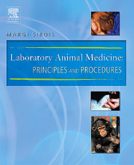|
|
|
| |
 |
|
|

|
 推薦指數:
推薦指數:





|
|
- 內容介紹
|
Laboratory Animal Medicine - Principles and Procedures
By Margi Sirois, EdD, MS, RVT
Approx. 368 pages, Approx. 100 illustrations, Copyright 2005
Softcover
Description
This combination text and lab manual provides clinically relevant coverage of laboratory animal medicine and procedures. It covers a variety of species, including rats, mice, guinea pigs, hamsters, rabbits, gerbils, ferrets, nonhuman primates, and in a separate chapter, nontraditional lab animals, such as swine, chinchillas, armadillos, reptiles, amphibians, bats, farm animals, and dogs and cats. Coverage of each species is presented in a consistent format that includes taxonomy, anatomy and physiology, uses in biomedical research, reproduction, behavior, husbandry, restraint and handling, identification methods, injection techniques, medication administration and anesthesia, blood collection, common diseases, and euthanasia. Other key topics include the laboratory setting, regulatory guidelines, and ethical considerations. The lab manual portion of the book features a variety of exercises and observation sheets.
Key Features
Comprehensive coverage of a variety of topics such as animal species, the laboratory setting, regulatory guidelines, and ethical considerations prepares readers for a career in laboratory animal medicine
Familiarizes readers with the handling, behavior, nutrition, and lab and treatment procedures for a large variety of common and nontraditional laboratory animals
The consistent organization of each species chapter makes it easy for readers to quickly identify similarities and differences among various laboratory animals
Laboratory exercises are included in a perforated section at the end of the book, allowing users to apply their knowledge and develop job skills
Features a wealth of user-friendly features such as a two-color design, learning objectives, key points, and review questions
Provides detailed information on specific legal and ethical requirements of lab animal care and use, including the ethics of pain management
Convenient boxes and tables provide quick access to important anatomic and physiologic data for each species
Discusses specific uses of each species in biomedical research, providing readers with a perspective on animal use that allows them to explain the benefits of animal use as required by veterinary technology program accreditation procedures
Table of Contents
Part One Principles of Laboratory Animal Medicine 1. Introduction to Laboratory Animal Medicine 2. The Research Environment Part Two Laboratory Animals 3. The Rat 4. The Mouse 5. The Guinea Pig 6. The Hamster, Gerbil, and Ferret 7. The Rabbit 8. Nonhuman Primates 9. Nontraditional Laboratory Animals Part Three Laboratory Manual 10. Laboratory Exercises
Author Information
By Margi Sirois, EdD, MS, RVT
|
|
|

